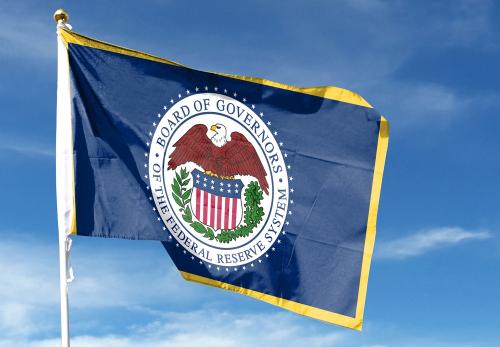This paper was presented on May 16, 2025 at the Federal Reserve Board’s Second Thomas Laubach Research Conference. Video of the presentation is available here.
Effective communication about what the Federal Reserve sees in the economy and how it plans to respond helps households and businesses better understand the economic outlook, clarifies and explains the Fed’s policy strategy, and builds trust and democratic accountability. The Fed is currently conducting its quinquennial review of its monetary policy framework, with the results to be announced later this year. Along with the tactics and tools of policy, the Fed will also review its communications—how policymakers talk (and listen) to the public, legislators, and financial market participants.
Over time and in response to changes in economic conditions and policy challenges, the Fed has constructed a sizable communications toolbox. This note, prepared for the Fed’s Thomas Laubach Research conference held in May 2025, reviews the Fed’s current communications practices, drawing comparisons with other major central banks and offering a brief assessment of the strengths and weaknesses of the Fed’s approach. Although the Fed’s communications strategy has some important strengths, I identify two closely related shortcomings that deserve attention.
First, the Fed’s announcements of its monetary policy decisions are accompanied by relatively little economic context or explanation, other than what emerges from the chair’s comments and answers to reporters’ questions in the press conference. In contrast, almost all other major central banks provide timely, detailed background information bearing on the policy decision, including reviews of recent developments in the economy and financial markets, discussions of monetary policy strategy, deep dives into substantive issues bearing on the decision, analyses of risks to the outlook, and the like. This additional information helps the public better understand the rationale for the policy decision and the factors that will determine policy in the future. This omission would not be particularly difficult to fix, if the Federal Open Market Committee (FOMC) chose to do so.
Second, also unlike almost all other major central banks, the Fed does not issue a baseline economic forecast in conjunction with its policy decisions. For practical reasons, as I will discuss, this omission is not easy to fix. Indeed, the FOMC tried and failed to develop a process for producing a collective forecast in 2012, eventually opting instead to stick with its Summary of Economic Projections, which reports projections of key economic variables submitted individually by the 19 FOMC participants.
Participants’ projections contain useful information, including about the range of views on the Committee. However, taken on their own, the projections are not an adequate substitute for a transparent, internally consistent macroeconomic forecast. Because of the lack of transparency about the assumptions that underlie the individual projections—together with the fact that, collectively, they do not necessarily reflect the post-meeting consensus of the Committee—the projections provide at best limited insight into why the implied outlook takes the shape it does, about the sources of changes in that outlook over time, or about the rationale for the policy strategy.
A particularly important drawback of the projections is that, by construction, they focus the public’s attention on what each participant sees as the most likely future path for the economy and policy, unhelpfully downplaying the large role of forecast uncertainty in policymaking. As I discuss, excessive emphasis on the baseline (modal) outlook impedes the ability of policymakers to discuss risk management considerations, to offer contingent forward guidance (or no forward guidance at all), or to shed light on the Committee’s reaction function—that is, how policy would respond if the economy were to take an unexpected turn.
This note suggests a way forward. Specifically, I propose that, along with the post-meeting policy announcement and participants’ projections, the Fed release once each quarter a relatively brief Economic Review (the title is provisional of course). Board staff would prepare the Review, possibly with contributions from the staffs of the regional Federal Reserve Banks, drawing heavily from the briefing materials prepared for the FOMC meeting. In analogy to the Monetary Policy Reports issued by other major central banks, the Review would include discussions of current economic and financial conditions, as well as in-depth analyses (e.g., of inflation trends) and special features as appropriate. Besides providing useful background information, this material would increase transparency by sharing with the public some of the factors that the Committee considered when making its policy decision.
The centerpiece of the proposed Review, however, would be forecasts of key economic and policy variables at varying horizons, drawn from a comprehensive macroeconomic forecast led and “owned” by the Board staff (possibly with some input and commentary from policymakers, as discussed below). Because the underlying forecast would be internally consistent and based on explicit economic assumptions, it would provide greater insight than the projections of individual FOMC participants into the factors affecting the outlook for the economy and policy. Critically, a fully articulated baseline forecast would also facilitate the public discussion of economic scenarios that differ from that baseline. Besides highlighting the inherent uncertainty of economic forecasts, the publication of selected alternative scenarios and their implications could facilitate a subtle but important shift in the Fed’s communications strategy. Specifically, it would allow the FOMC to provide policy guidance that is more explicitly contingent on how the economy evolves, underscoring for the public that the future path of policy is not unconditional (“on a preset course”) but depends sensitively on economic developments and risk management considerations.
-
Acknowledgements and disclosures
I thank Alex Conner for excellent research assistance and David Wessel and Donald Kohn for helpful comments.
The Brookings Institution is committed to quality, independence, and impact.
We are supported by a diverse array of funders. In line with our values and policies, each Brookings publication represents the sole views of its author(s).









